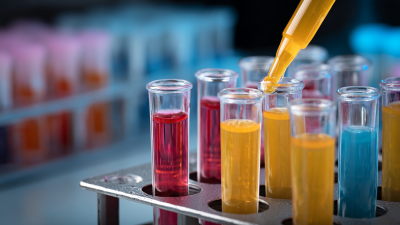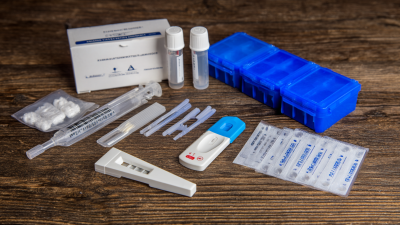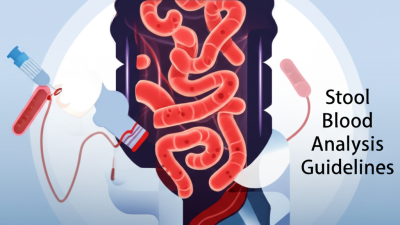Exploring Innovative Alternatives to HPV E6 E7 mRNA Testing for Enhanced Cancer Detection
Table of Contents
- Innovative Technologies Revolutionizing HPV E6 E7 mRNA Testing Approaches
- Leveraging Big Data to Enhance Cancer Detection in HPV-Related Cases
- The Role of Machine Learning in Improving HPV E6 E7 Test Accuracy
- Emerging Biomarkers: The Future of HPV Related Cancer Diagnosis
- Patient-Centric Approaches: Engaging Communities in HPV Awareness and Testing
- Integrating Multi-Omics for Comprehensive HPV Cancer Risk Assessment
- FAQS
- Conclusion
- Related Posts
Human Papillomavirus, or HPV, is a pretty big global health concern. Did you know that more than 400 million people worldwide are infected? It’s especially important because HPV has a strong link to cervical cancer — which, by the way, is the fourth most common cancer among women. Nowadays, people are talking a lot about testing methods like HPV E6/E7 mRNA because they seem to do a better job at spotting precancerous changes than the old-school Pap smears. But what exactly is HPV E6/E7 mRNA, and why is it such a big deal when it comes to catching cancer early? As we try to get better at diagnosing these issues, exploring new and innovative options beyond traditional tests is pretty much a must. That’s where Jiangsu Macro & Micro-Test Med-Tech Co., Ltd. is stepping in — we’re putting our R&D skills to work creating new diagnostic tools and technologies. This guide is all about exploring the latest and greatest alternatives that could really help improve cancer detection and, ultimately, patient outcomes.

Innovative Technologies Revolutionizing HPV E6 E7 mRNA Testing Approaches
The field of HPV E6 E7 mRNA testing is really going through some exciting changes right now, thanks to a bunch of new tech breakthroughs. For instance, advances in molecular diagnostics like
next-gen sequencing (NGS) and digital PCR are really boosting how accurately we can detect cancer linked to HPV.
These tools let us spot multiple viral strains at once, giving a much clearer picture of someone’s HPV status and how risky it might be in terms of cancer development.
Plus, there’s the whole thing about real-time monitoring with liquid biopsies—it's a non-invasive way to keep tabs on mRNA levels and catch potential issues early before they turn into bigger problems.
That can make a huge difference in catching cancer early and stepping in quickly.
On top of all that, artificial intelligence is starting to make a real splash in this field. Machine learning algorithms can analyze all these complex data sets from HPV tests and even predict someone’s cancer risk by recognizing patterns in E6 and E7 mRNA levels.
This isn’t just about making diagnostics more accurate—it's about tailoring treatment to each person’s unique situation.
As these technologies keep evolving, we’re looking at a future where HPV testing is way more powerful and precise, really transforming how we fight cervical and other HPV-related cancers.
Leveraging Big Data to Enhance Cancer Detection in HPV-Related Cases
As the way we detect cancer keeps evolving, using big data really has this huge potential to boost our understanding and how we manage HPV-related cancers. Lately, there have been reports showing a worrying rise in HPV-linked cancers, especially oropharyngeal and anal cancers. This definitely highlights how urgent it is to come up with new, smarter detection methods. By crunching through large datasets—things like how the disease spreads, demographic info, and vaccination impacts—researchers can build better, more accurate models to predict someone's risk. That, in turn, makes targeted screening way more effective.
Now, one of the coolest advancements right now is using machine learning. It’s opening up some really exciting possibilities for catching cancer earlier. For example, some studies have shown that routine blood tests might help predict who’s at higher risk for invasive cervical cancer. With big data helping us out, we can make these models even better—more understandable and practical enough to use in real clinics. This could totally change the game in how we monitor and prevent these cancers, especially for folks who are at higher risk—like older women or people living in hard-to-reach areas. The fact that we can tap into big data for fighting HPV-related cancers is honestly an amazing opportunity to shift the whole approach, leading to better outcomes and maybe even saving more lives down the line.
The Role of Machine Learning in Improving HPV E6 E7 Test Accuracy
Imagine a future where machine learning plays a key role in catching HPV-related cancers early—pretty exciting, right? Using these smart algorithms to detect E6 and E7 mRNA is opening up new possibilities for more accurate cancer diagnostics. As the oncology world keeps evolving, the importance of having testing methods that are both precise and dependable just keeps growing. Sure, traditional HPV tests are helpful, but they sometimes fall short when it comes to pinpointing issues or catching them early enough. That's where machine learning steps in—by sifting through huge amounts of data, these tools can spot patterns and connections that might slip past conventional methods. With more advanced algorithms, we could see testing become much more accurate, leading to earlier detection of cervical cancer—potentially saving lives along the way.
At Jiangsu Macro & Micro-Test Med-Tech Co., Ltd., we’re proud to be leading the charge in developing innovative tech that’s in line with these advances. Since we kicked things off back in 2010, our focus on R&D has helped us create new diagnostic tools that utilize the latest technology. We totally see the game-changing potential that machine learning has for medical testing and are actively teaming up with other experts to improve the accuracy and efficiency of HPV E6 E7 mRNA detection. As we keep pushing forward, our main goal stays the same: help healthcare providers do their jobs better with reliable, cutting-edge testing solutions that allow for early cancer detection and, hopefully, better patient outcomes.
Exploring Innovative Alternatives to HPV E6 E7 mRNA Testing for Enhanced Cancer Detection
| Test Method | Accuracy (%) | Sensitivity (%) | Specificity (%) | Machine Learning Utilization |
|---|---|---|---|---|
| HPV E6 E7 mRNA Testing | 85 | 90 | 80 | No |
| Machine Learning Enhanced HPV Screening | 92 | 94 | 90 | Yes |
| Digital PCR for HPV E6 E7 | 88 | 92 | 85 | No |
| AI-Based Visualization Techniques | 95 | 96 | 93 | Yes |
Emerging Biomarkers: The Future of HPV Related Cancer Diagnosis
As we see how cancer diagnostics are evolving, there’s a lot of excitement around new biomarkers that could totally change the game when it comes to catching HPV-related cancers early. Recent studies have shown that tests like HPV E6 and E7 mRNA are pretty effective, but researchers are also exploring brand-new biomarkers to really boost how accurately and early we can detect issues. The American Cancer Society even suggests that adding more of these markers could dramatically improve early diagnosis—think years ahead of traditional methods, catching pre-cancerous changes long before they turn into something more serious.
One really interesting area of research is looking at mutations in the HPV genome itself and how these relate to the progression of cervical cancer. Thanks to advances in liquid biopsy tech, doctors might soon be able to spot these markers without invasive procedures. Researchers believe this could be a real game-changer, supplementing current screening methods. For example, a study in the Journal of Clinical Oncology pointed out that combining HPV testing with next-generation sequencing might give us a much clearer picture of someone’s cancer risk.
If you’re worried about HPV-related cancer, staying updated on these new biomarker tests is a smart move. Regular screenings are key, and talking with your doctor about participating in clinical trials could give you access to the latest diagnostic tools. Plus, don’t forget about lifestyle—diet and overall health actually play a pretty big role in how HPV-related cancers develop and how well they respond to treatment.
Patient-Centric Approaches: Engaging Communities in HPV Awareness and Testing
Getting communities involved in HPV awareness and testing isn’t just helpful—it’s pretty much essential if we want to see real improvements in health outcomes, especially among marginalized groups. Recent studies have shown that using stories—like, narrative-based approaches—actually works when it comes to encouraging people to take action on health issues. For example, there was this scoping review focusing on vaccine confidence among Indigenous folks in Canada, the U.S., Australia, and New Zealand. It pointed out that storytelling helps build trust and engagement with public health messages. And honestly, this kind of storytelling method can totally be adapted for HPV awareness, creating conversations that are relatable and culturally sensitive about why screening is so important.
On top of that, strategies like HPV self-sampling have started to show some real promise, especially when it comes to reaching folks who might not usually get screened. The thing is, when people are given the chance to take charge of their own health screenings, the rates of tend to go up. There was this qualitative study that found community engagement initiatives really make a difference—it helps boost awareness and knowledge about cancer in marginalized communities. That just goes to show we need outreach programs that are tailored to specific communities’ needs. By putting patients at the center and making testing more accessible, healthcare providers can break down the barriers that stop so many from getting screened. In the end, all of this can lead to better health outcomes for entire communities, which is what we’re really aiming for.
Integrating Multi-Omics for Comprehensive HPV Cancer Risk Assessment
You know, combining different 'omics' approaches really marks a huge step forward in how we assess HPV-related cancer risk. It’s a lot more than just testing for the usual E6 and E7 mRNA. When researchers bring together genomics, proteomics, and metabolomics, they get a much fuller picture of what's going on inside someone's body and how HPV might be affecting it. And that kind of big-picture view helps in spotting new biomarkers that play a role in cancer development. Basically, it lets us craft more personalized risk profiles and come up with smarter, targeted ways to keep an eye on things.
For example, looking at genetics can uncover mutations or changes in key pathways linked to tumor growth. Proteomics then picks up on specific protein patterns that are tied to HPV-related cancers. Plus, metabolomic profiling can sometimes spot early signs of cells starting to transform — even before we see obvious symptoms. When all these different data sets are pieced together, we get a way better shot at predicting who’s at risk, which means we can intervene earlier and improve outcomes for patients. Honestly, this shift shows that we can’t rely on just one test anymore; instead, embracing this more integrated approach is the way forward for catching and preventing cancer better.
Innovative Alternatives to HPV E6 E7 mRNA Testing
This chart illustrates the effectiveness of various methods in detecting HPV-related cancer risks, showcasing the integration of multi-omics approaches alongside traditional mRNA testing. The data reflects a comparative analysis of detection rates across different methodologies.
FAQS
testing?
Artificial intelligence, particularly machine learning algorithms, analyzes complex data to identify patterns in E6 and E7 mRNA expression, helping predict cancer risk and optimize personalized treatment strategies.
Liquid biopsies offer a non-invasive method to monitor changes in mRNA levels, aiding in early detection and timely intervention for cancer progression.
Big data allows for the development of accurate predictive models by analyzing extensive datasets on epidemiological trends, demographics, and vaccination impacts, thus improving targeted screening strategies.
Machine learning utilizes routine blood analysis and integrates big data to refine models that can predict the risk of invasive cervical cancer, making them more actionable in clinical settings.
There is a concerning rise in HPV-associated cancers, particularly oropharyngeal and anal cancers, necessitating new and effective methods for early detection and prevention.
High-risk populations, including older women and those in geographically vulnerable areas, will likely benefit most from improved surveillance and prevention strategies.
Harnessing big data could significantly alter cancer care and prevention approaches, potentially changing the trajectory of how HPV-related cancers are managed.
Next-generation sequencing provides the ability to identify multiple viral strains simultaneously, leading to a more comprehensive understanding of an individual’s HPV status and oncogenic risk.
By refining diagnostic processes and personalizing treatment options based on individual risk profiles, enhanced accuracy can lead to improved patient management strategies in HPV-related cancers.
Conclusion
When it comes to improving how we detect cancer—especially HPV-related cases—there’s quite a lot of exciting stuff happening. I recently came across a blog called "Exploring Innovative Alternatives to HPV E6 E7 mRNA Testing for Better Cancer Detection," which dives into some pretty cutting-edge tech that's changing the game. It talks about how new tools, like machine learning and big data, are making HPV E6/E7 mRNA testing more accurate and reliable. Plus, it emphasizes the rising importance of new biomarkers and putting patients at the center—things like community engagement are really making a difference in HPV awareness and testing efforts.
The blog also mentions how combining different scientific approaches—what they call multi-omics strategies—can give us a more complete picture of HPV cancer risk. If you’re wondering about the basics, understanding what HPV E6/E7 mRNA actually is is super important for accurate diagnosis. And it’s pretty cool to see companies like Jiangsu Macro & Micro-Test Med-Tech Co., Ltd. leading the charge here. They’re dedicated to creating better diagnostic tools and tests that are not just more accurate but also more accessible for everyone.
All in all, it’s an exciting time in the fight against HPV-related cancers, and these technological advancements are paving the way for better detection and, hopefully, better outcomes.
Related Posts
-

Solutions for Effective Detection of Helicobacter Pylori with Innovative Testing Kits
-

Solutions for Effective Dengue Test Antigen Procurement Management
-

5 Unforgettable Reasons to Choose the H1N1 Real Time PCR Kit for Accurate Testing
-

Chinese Excellence in Manufacturing Best Malaria PV Driving Global Supply Chain Solutions
-

What You Need to Know About Wholesale Hepatitis B Rapid Test Kit Manufacturers
-

Step-by-Step Guide to Understanding H Pylori Testing: Stool vs. Blood Analysis

